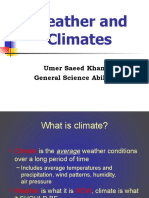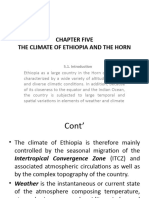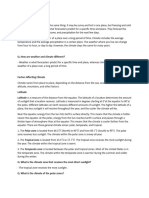ch13 Sec1
ch13 Sec1
Uploaded by
api-272720493Copyright:
Available Formats
ch13 Sec1
ch13 Sec1
Uploaded by
api-272720493Original Title
Copyright
Available Formats
Share this document
Did you find this document useful?
Is this content inappropriate?
Copyright:
Available Formats
ch13 Sec1
ch13 Sec1
Uploaded by
api-272720493Copyright:
Available Formats
Atmosphere and Climate Change
Section 1: Climate and Climate Change
Preview
Bellringer
Objectives
Climate
Latitude
Atmospheric Circulation
Global Circulation Patters
Prevailing Winds
Section 1
Atmosphere and Climate Change
Section 1: Climate and Climate Change
Preview, continued
Oceanic Circulation
El NioSouthern Oscillation
Pacific Decadal Oscillation
Topography
Other Influences on Earths Climate
Seasonal Changes in Climate
Section 1
Atmosphere and Climate Change
Bellringer
Section 1
Atmosphere and Climate Change
Section 1
Objectives
Explain the difference between weather and climate.
Identify four factors that determine climate.
Explain why different parts of the Earth have different
climates.
Explain what causes the seasons
Atmosphere and Climate Change
Section 1
Climate
Climate is the average weather conditions in an area
over a long period of time.
Climate is determined by a variety of factors that include
latitude, atmospheric circulation patterns, oceanic
circulation patterns, the local geography of an area, solar
activity, and volcanic activity.
The most important of these factors is distance from the
equator.
Atmosphere and Climate Change
Section 1
Latitude
Latitude is the distance north or south from the equator
and is expressed in degrees.
The equator is located at 0 latitude.The most northerly
latitude is the North Pole, at 90 north, whereas the most
southerly latitude is the South Pole, at 90 south.
Latitude strongly affects climate because the amount of
solar energy an area of the Earth receives depends on
its latitude.
Atmosphere and Climate Change
Section 1
Low Latitudes
More solar energy falls on areas near the equator than
on areas closer to the poles.
The incoming solar energy is concentrated on a small
surface at the equator.
In regions near the equator, night and day are both about
12 hours long throughout the year.
In addition, temperatures are high year-round, and there
are no summers or winters.
Atmosphere and Climate Change
Section 1
High Latitudes
In regions closer the poles, the sun is lower in the sky,
reducing the amount of energy arriving at the surface.
In the northern and southern latitudes, sunlight hits the
Earth at an oblique angle and spreads over a larger
surface area than it does at the equator.
Yearly average temperatures near the poles are
therefore lower than they are at the equator.
Atmosphere and Climate Change
Section 1
High Latitudes
The hours of daylight also vary. At 45 north and south
latitude, there is as much as 16 hours of daylight each
day during the summer and as little as 8 hours of
sunlight each day in the winter.
Near the poles, the sun sets for only a few ours each day
during the summer and rises for only a few hours each
day during the winter.
Thus, the yearly temperature range near the poles is
very large.
Atmosphere and Climate Change
Low and High Latitudes
Section 1
Atmosphere and Climate Change
Section 1
Atmospheric Circulation
Three important properties of air illustrate how air
circulation affects climate.
Cold air sinks because it is denser than warm air. As
the air sinks, it compresses and warms.
Warm air rises. It expands and cools as it rises.
Warm air can hold more water vapor than cold air
can. Therefore, when warm air cools, the water vapor
it contains may condense into liquid water to form
rain, snow, or fog.
Atmosphere and Climate Change
Section 1
Atmospheric Circulation
Solar energy heats the ground, which warms the air
above it. This warm air rises, and cooler air moves in to
replace it. This movement of air within the atmosphere is
called wind.
Because the Earth rotates, and because different
latitudes receive different amounts of solar energy, a
pattern of global atmospheric circulation results.
This circulation pattern determines Earths precipitation
patterns.
Atmosphere and Climate Change
Atmospheric Circulation
Section 1
Atmosphere and Climate Change
Section 1
Atmospheric Circulation
For example, the intense solar energy striking the Earths
surface at the equator causes the surface as well as the
air above the equator to become very warm.
This warm air can hold large amounts of water vapor.
But as this warm air rises and cools, its ability to hold
water is reduced.
As a result, areas near the equator receive large
amounts of rain.
Atmosphere and Climate Change
Section 1
Global Circulation Patterns
Cool air normally sinks, but cool air over the equator
cannot descend because hot air is rising up below it.
This cool air is forced away from the equators toward the
North and South Poles where it accumulates at about
30 north latitude and 30 south latitude.
Some of the air sinks back to the Earths surface and
becomes warmer as it descends. This warm, dry air then
moves across the surface and causes water to
evaporate from the land below, creating dry conditions.
Atmosphere and Climate Change
Section 1
Global Circulation Patters
Air descending at the 30 north and 30 south latitude
either moves toward the equator or flows toward the
poles. Air moving toward the equator warms while it is
near the Earths surface.
At about 60 north and 60 south latitudes, this air
collides with cold air traveling from the poles.
The warm air rises, and most of this uplifted air is forced
toward the poles. Cold, dry air descends at the poles,
which are essentially very cold deserts.
Atmosphere and Climate Change
Section 1
Prevailing Winds
Winds that blow predominantly in one direction
throughout the year are called prevailing winds.
Because of the rotation of the Earth, these winds do not
blow directly northward or southward.
Instead, they are deflected to the right in the Northern
Hemisphere and to the left in the Southern Hemisphere.
Atmosphere and Climate Change
Section 1
Prevailing Winds
Belts of prevailing winds are produced in both
hemispheres between 30 north and south latitude and
the equator.
These belts of winds are called the trade winds.
The trade winds blow from the northeast in the Northern
Hemisphere and from the southeast in the Southern
Hemisphere.
Atmosphere and Climate Change
Section 1
Prevailing Winds
Prevailing winds known as the westerlies are produced
between 30 and 60 north latitude and 30 and 60
south latitude.
In the Northern Hemisphere, these westerlies are
southwest winds, and in the Southern Hemisphere,
these winds are northwest winds.
The polar easterlies blow from the poles to 60 north and
south latitude.
Atmosphere and Climate Change
Section 1
Oceanic Circulation
Ocean currents have a great effect on climate because
water holds large amounts of heat.
The movement of surface ocean currents is caused
mostly by winds and the rotation of the Earth.
These surface currents redistribute warm and cool
masses of water around the world and in doing so, they
affect the climate in many parts of the world.
Atmosphere and Climate Change
Section 1
El NioSouthern Oscillation
El Nio is the warm phase of the El NioSouthern
Oscillation. It is the periodic occurrence in the eastern
Pacific Ocean in which the surface-water temperature
becomes unusually warm.
During El Nio, winds in the western Pacific Ocean,
which are usually weak, strengthen and push warm
water eastward.
Rainfall follows this warm water eastward and produces
increased rainfall in the southern half on the U.S., but
drought in Australia.
Atmosphere and Climate Change
Section 1
El NioSouthern Oscillation
La Nia is the cool phase of the El NioSouthern
oscillation. It is the periodic occurrence in the eastern
Pacific Ocean in which the surface water temperature
becomes unusually cool.
El Nio and La Nia are opposite phases of the El Nio
Southern Oscillation (ENSO) cycle.
Atmosphere and Climate Change
El NioSouthern Oscillation
Section 1
Atmosphere and Climate Change
Section 1
Pacific Decadal Oscillation
The Pacific Decadal Oscillation (PDO) is a long-term, 20
to 30 year change in the location of warm and cold water
masses in the Pacific Ocean.
PDO influences the climate in the northern Pacific Ocean
and North America.
It affects ocean surface temperatures, air temperatures,
and precipitation patterns.
Atmosphere and Climate Change
Section 1
Topography
Height above sea level (elevation) has an important
effect on climate. Temperatures fall by about 6C (about
11F) for every 1,000 m increase in elevation.
Mountain ranges also influence the distribution of
precipitation. For example, warm air from the ocean
blows east, hits the mountains, and rises. As the air
rises, it cools, causing it to rain on the western side of
the mountain. When the air reaches the eastern side of
the mountain it is dry. This effect is known as a rain
shadow.
Atmosphere and Climate Change
Topography
Section 1
Atmosphere and Climate Change
Section 1
Other Influences on Earths Climate
Both the sun and volcanic eruptions influence Earths
climate.
At a solar maximum, the sun emits an increased amount
of ultraviolet (UV) radiation. UV radiation produces more
ozone, which warms the stratosphere.
The increased solar radiation can also warm the lower
atmosphere and surface of the Earth a little.
Atmosphere and Climate Change
Section 1
Other Influences on Earths Climate
In large-scale volcanic eruptions, sulfur dioxide gas can
reach the upper atmosphere.
The sulfur dioxide, which can remain in the atmosphere
for up to 3 years, reacts with smaller amounts of water
vapor and dust in the stratosphere.
This reaction forms a bright layer of haze that reflects
enough sunlight to cause the global temperature to
decrease.
Atmosphere and Climate Change
Section 1
Seasonal Changes in Climate
The seasons result from the tilt of the Earths axis, which
is about 23.5 relative to the plane of its orbit.
Because of this tilt the angle at which the suns rays
strike the Earth changes as the Earth moves around the
sun.
Atmosphere and Climate Change
Seasonal Changes in Climate
Section 1
Atmosphere and Climate Change
Section 1
Seasonal Changes in Climate
During summer in the Northern Hemisphere, the
Northern Hemisphere tilts toward the sun and receives
direct sunlight. The number of hours of daylight is
greatest in the summer. Therefore, the amount of time
available for the sun to heat the Earth becomes greater.
During summer in the Northern Hemisphere, the
Southern Hemisphere tilts away from the sun and
receives less direct sunlight. But, during the summer in
the Southern Hemisphere, the situation is reversed.
Atmosphere and Climate Change
Quick LAB
Section 1
Atmosphere and Climate Change
Math Practice
Section 1
You might also like
- Grade 11 Geography Atmosphere NotesDocument125 pagesGrade 11 Geography Atmosphere Notesprismred1100% (6)
- Exciter Vibrating Screen Rs TipDocument1 pageExciter Vibrating Screen Rs TipchrisNo ratings yet
- Experiment No. 5 1Document6 pagesExperiment No. 5 1JunNo ratings yet
- Weather and Climate AutosavedDocument44 pagesWeather and Climate Autosavedcrossline093No ratings yet
- Biol448 L2Document57 pagesBiol448 L2shimaa aldamenNo ratings yet
- Eeb Unit 1Document111 pagesEeb Unit 1Aafreen AbuthahirNo ratings yet
- 11mss Earth Chapter14Document111 pages11mss Earth Chapter14igyanchandaniNo ratings yet
- Grade 9 ScienceDocument8 pagesGrade 9 ScienceChristian jade QuijanoNo ratings yet
- Factors That Affect ClimateDocument71 pagesFactors That Affect ClimateChristine CayosaNo ratings yet
- Geography term2Document16 pagesGeography term2lewele0105No ratings yet
- Factors Affecting Climate: Quarter 3 Weeks 5-6Document51 pagesFactors Affecting Climate: Quarter 3 Weeks 5-6Patricia SamsonNo ratings yet
- Factors That Affect ClimateDocument21 pagesFactors That Affect ClimateNNo ratings yet
- Factors That Affect ClimateDocument18 pagesFactors That Affect ClimateAngelica Marie JacintoNo ratings yet
- ClimateDocument38 pagesClimateReima MilleraNo ratings yet
- Air Sea Notes PDFDocument9 pagesAir Sea Notes PDFfyh2tp2fjkNo ratings yet
- Weather & ClimateDocument38 pagesWeather & Climatejenjang yannie100% (1)
- Unit 5Document64 pagesUnit 5Thomas GebeyehuNo ratings yet
- Earth Sun Relationships Lesson PresentationDocument28 pagesEarth Sun Relationships Lesson PresentationMarianne B. HingpesNo ratings yet
- Climate - WeatherDocument41 pagesClimate - WeatherHamza MujahidNo ratings yet
- Geog Eth_Chapter 5_WUDocument49 pagesGeog Eth_Chapter 5_WUhabibyesuf81No ratings yet
- The Restless AtmosphereDocument59 pagesThe Restless Atmosphereapi-238230757No ratings yet
- Atmospheric Circulation and Weather SystemDocument8 pagesAtmospheric Circulation and Weather SystemAnkitNo ratings yet
- Elements Climatology Lesson 2Document13 pagesElements Climatology Lesson 2Manish Bokdia50% (2)
- LART1004-Chapter-5 (1)Document48 pagesLART1004-Chapter-5 (1)Axmad CabdiNo ratings yet
- LS2.1_V3_ClimateDocument19 pagesLS2.1_V3_Climatexeyoron233No ratings yet
- Climate and Veg-WPS OfficeDocument32 pagesClimate and Veg-WPS OfficelefeawologNo ratings yet
- Weather and ClimateDocument22 pagesWeather and ClimateJansen CadornaNo ratings yet
- Geog GR11 Term 3 Test 2 2024 FinalDocument33 pagesGeog GR11 Term 3 Test 2 2024 Finalmakatuadivhaho28No ratings yet
- ClimateDocument14 pagesClimateapi-340406981No ratings yet
- WWW Studyrankers Com 2020 05 Notes of CH 10 Atmospheric CircDocument12 pagesWWW Studyrankers Com 2020 05 Notes of CH 10 Atmospheric Circvashuok081No ratings yet
- Different Factors Affect The Climate of An Area: Science 9 Quarter Iii WEEK 5&6 Lesson 4Document38 pagesDifferent Factors Affect The Climate of An Area: Science 9 Quarter Iii WEEK 5&6 Lesson 4jesterrodriguez79No ratings yet
- Chapter 4: AtmosphereDocument13 pagesChapter 4: AtmosphereRemudin Reshid MekuriaNo ratings yet
- Atmospheric Movement Powerpoint NXPowerLiteDocument32 pagesAtmospheric Movement Powerpoint NXPowerLiteSrinivas RNo ratings yet
- Ocean CurrentsDocument27 pagesOcean CurrentsAdrian D. MasinadingNo ratings yet
- Introduction To Climate: - Engr. Dielene F. de GuzmanDocument42 pagesIntroduction To Climate: - Engr. Dielene F. de GuzmanHeiro KeystrifeNo ratings yet
- Chapter Five and SixDocument70 pagesChapter Five and Sixyaredkidus879No ratings yet
- Chapter FiveDocument104 pagesChapter Fivebekelewudu6No ratings yet
- Basic of Wind EnergyDocument24 pagesBasic of Wind EnergyG ChandrasekaranNo ratings yet
- Unit-Iii - Types of Natural Disasters - Final - 19-Sep-2022Document72 pagesUnit-Iii - Types of Natural Disasters - Final - 19-Sep-2022Shaik Asif Ali civilNo ratings yet
- CirculationDocument45 pagesCirculationMatthew WongNo ratings yet
- Factors That Affect ClimateDocument14 pagesFactors That Affect ClimateGuiaNo ratings yet
- CH 13 Atmosphere and Climate ChangeDocument24 pagesCH 13 Atmosphere and Climate Changencl12142No ratings yet
- Chaper 9Document8 pagesChaper 9vashuok081No ratings yet
- Weather, Climate, Vegetation and Soil - Part 1Document39 pagesWeather, Climate, Vegetation and Soil - Part 1sadninja008No ratings yet
- Freshman Geography Lecture 5Document66 pagesFreshman Geography Lecture 5Aidan100% (1)
- Meteorology: Private Pilot LicenseDocument93 pagesMeteorology: Private Pilot LicenseChristian Cesar C. CebrecusNo ratings yet
- ClimateDocument54 pagesClimateJolly RiveraNo ratings yet
- Climate 2021Document24 pagesClimate 2021Chubby BunnyNo ratings yet
- GEOG203 04 Circulation Patterns TemperatureDocument78 pagesGEOG203 04 Circulation Patterns TemperatureTian Rui WangNo ratings yet
- NF - Weather and ClimateDocument3 pagesNF - Weather and Climatejoannekim1931No ratings yet
- Solar Radiation, Heat Balance and Temperature Chapter 8 - Class 11 Geography NCERT - Class Notes - Samagra Book Series Batch (Hinglish)Document30 pagesSolar Radiation, Heat Balance and Temperature Chapter 8 - Class 11 Geography NCERT - Class Notes - Samagra Book Series Batch (Hinglish)avnish.k.verma.2014No ratings yet
- STS Report Climate ChangeDocument10 pagesSTS Report Climate ChangeBoton, Ivan Ray C.No ratings yet
- Atmospheric ProcessesDocument3 pagesAtmospheric ProcessesGaozheng RelinquishNo ratings yet
- 1-The Origin of WindsDocument43 pages1-The Origin of Windsiisa8aNo ratings yet
- Climate & Built Environment-PresentationDocument37 pagesClimate & Built Environment-PresentationAtshayaNo ratings yet
- Interactive Textbook Section One What Is Climate 17 1 1 1Document8 pagesInteractive Textbook Section One What Is Climate 17 1 1 1api-249771030100% (1)
- Chapter Five The Climate of Ethiopia and The HornDocument358 pagesChapter Five The Climate of Ethiopia and The HornAmanuel Mintesinot100% (3)
- Weather Copy 2Document13 pagesWeather Copy 2api-240158555100% (1)
- Weather and Climate-2ndDocument78 pagesWeather and Climate-2ndDwayne Lyndon GutierrezNo ratings yet
- Meteo Module 9Document44 pagesMeteo Module 9carlgavinsletartigasNo ratings yet
- Questions and Answers about: Planet EarthFrom EverandQuestions and Answers about: Planet EarthRating: 3 out of 5 stars3/5 (1)
- Park DBQ: InstructionsDocument1 pagePark DBQ: Instructionsapi-272720493No ratings yet
- America Aljazeera Com-Worlds Largest Tax-Funded Site of Mass Graves Might Be Turned Into A ParkDocument2 pagesAmerica Aljazeera Com-Worlds Largest Tax-Funded Site of Mass Graves Might Be Turned Into A Parkapi-272720493No ratings yet
- ch08 Sec1Document26 pagesch08 Sec1api-272720493No ratings yet
- Env Stream LabDocument3 pagesEnv Stream Labapi-272720493No ratings yet
- Travel Brochure of A CellDocument1 pageTravel Brochure of A Cellapi-272720493No ratings yet
- Chemistry of Life FoldableDocument2 pagesChemistry of Life Foldableapi-272720493No ratings yet
- Invite EsDocument1 pageInvite Esapi-272720493No ratings yet
- Invite PsDocument1 pageInvite Psapi-272720493No ratings yet
- InviteDocument1 pageInviteapi-272720493No ratings yet
- Agriculture Fact Sheet Jackson 2009Document4 pagesAgriculture Fact Sheet Jackson 2009api-272720493No ratings yet
- EcologyDocument92 pagesEcologyapi-272720493No ratings yet
- Kingdom Taxonomy Project 15Document5 pagesKingdom Taxonomy Project 15api-272720493No ratings yet
- The C-Tower ProjectDocument5 pagesThe C-Tower ProjectRonaldo KasperNo ratings yet
- 3 MewsDocument146 pages3 Mewsdiana100% (1)
- Model Asset Exchange (MAX) and The Data Asset Exchange (DAX) IBM DeveloperDocument7 pagesModel Asset Exchange (MAX) and The Data Asset Exchange (DAX) IBM Developersuvratml21No ratings yet
- Optika Id 91 Ganter Florian 2011Document58 pagesOptika Id 91 Ganter Florian 2011MartinKampffNo ratings yet
- Kendriya Vidyalaya Sangathan: /lets Spi:k Ingli - TudeiDocument39 pagesKendriya Vidyalaya Sangathan: /lets Spi:k Ingli - TudeiGovinda PatraNo ratings yet
- Low Carbon Energy Transitions in Qatar and The GCCDocument93 pagesLow Carbon Energy Transitions in Qatar and The GCCLDaggersonNo ratings yet
- Recto Memorial National High SchoolDocument2 pagesRecto Memorial National High SchoolTiger LilyNo ratings yet
- Basic Principles of Heat TreatmentDocument4 pagesBasic Principles of Heat TreatmentHarpreet AroraNo ratings yet
- HPC 9DJ 23 0001 2012 SubDocument36 pagesHPC 9DJ 23 0001 2012 SubSheik HussainNo ratings yet
- Chapter 11 - Dryland Strategies - A Permaculture Design Course HandbookDocument8 pagesChapter 11 - Dryland Strategies - A Permaculture Design Course Handbookikhlas65No ratings yet
- I. Objectives: Write The LC Code For EachDocument5 pagesI. Objectives: Write The LC Code For EachSittie Asnile MalacoNo ratings yet
- UK - Relative Humidity ChartsDocument11 pagesUK - Relative Humidity ChartsShamaNo ratings yet
- Rainfall Characterization and AnalysisDocument5 pagesRainfall Characterization and Analysislipsapanda333No ratings yet
- Guidelines For Long Lasting Bituminous Pavements in IndiaDocument36 pagesGuidelines For Long Lasting Bituminous Pavements in IndiaProf. Prithvi Singh Kandhal100% (2)
- KSIF Kenya Strategic Investment Framework On SLM 2017 2027Document129 pagesKSIF Kenya Strategic Investment Framework On SLM 2017 2027NIMRODNo ratings yet
- Tile Grout: Report Assignment 1Document48 pagesTile Grout: Report Assignment 1Ardiansah -No ratings yet
- Bulat Tomas - Economia DescubiertaDocument256 pagesBulat Tomas - Economia DescubiertaAlberto Luis Acón Pichel100% (1)
- Paracaídas Instantáneo Dynatech/ Parachute Instantane DynatechDocument9 pagesParacaídas Instantáneo Dynatech/ Parachute Instantane DynatechJuan IribarrenNo ratings yet
- Hazard Assessment ReportDocument7 pagesHazard Assessment ReportWilliam ProvidoNo ratings yet
- The Voice of The Rain Extract Based and Short Q ADocument2 pagesThe Voice of The Rain Extract Based and Short Q Aayu791973No ratings yet
- Effect of Temperature On Magnetic StrengthDocument27 pagesEffect of Temperature On Magnetic Strengthihisulzer57% (7)
- Unit 2 ExercisesDocument10 pagesUnit 2 ExercisesAlberto Rivas CidNo ratings yet
- Nido de Serpientes (Victoria Holt)Document336 pagesNido de Serpientes (Victoria Holt)arqmareggNo ratings yet
- Future Tenses: Marcela Borges Prado Letras DiurnoDocument42 pagesFuture Tenses: Marcela Borges Prado Letras DiurnoMarcela Borges Prado100% (1)
- 2 - Calcul Coeficientului Global de Izolare Termica GDocument4 pages2 - Calcul Coeficientului Global de Izolare Termica GAlexandru CojocaruNo ratings yet
- The Wind FairiesDocument104 pagesThe Wind Fairiesdubiluj100% (7)
- Module 1-Solar Energy Technologies-Part 1Document72 pagesModule 1-Solar Energy Technologies-Part 1ellenasirifi6No ratings yet
- Architecture SpecificationDocument70 pagesArchitecture SpecificationgunsakNo ratings yet





































































































